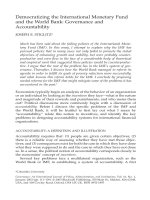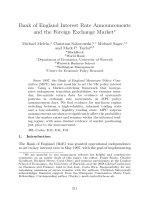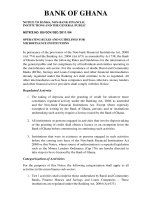International Financial Market and Korean Economy Introduction to exchange rates and the foreign exchange market
Bạn đang xem bản rút gọn của tài liệu. Xem và tải ngay bản đầy đủ của tài liệu tại đây (581.84 KB, 54 trang )
International Financial market and Korean Economy
Prepared by Seok-Kyun HUR
Introduction to Exchange Rates and the Foreign Exchange Market
Introduction
Exchange rates affect large flows of international trade by
influencing the prices in different currencies.
Foreign exchange also facilitates massive flows of
international investment, which include direct investments
as well as stock and bond trades.
In the foreign exchange market, trillions of dollars are
traded each day and the economic implications of shifts in
the market can be dramatic.
Introduction
The topics we cover today include:
• exchange rate basics
• basic facts about exchange rate behavior
• the foreign exchange market
• two key market mechanisms: arbitrage and expectations
1 Exchange Rate Essentials
• An exchange rate (E) is the price of some foreign currency
expressed in terms of a home (or domestic) currency.
• Because an exchange rate is the relative price of two
currencies, it may be quoted in either of two ways:
1. The number of home currency units that can be
exchanged for one unit of foreign currency.
2. The number of foreign currency units that can be
exchanged for one unit of home currency.
• Knowing the format in which exchange rates are quoted is
essential to avoid confusion, so we now establish a
systematic rule, even if it is arbitrary.
1 Exchange Rate Essentials
Defining the Exchange Rate
• To avoid confusion, we must specify which country is
the home country and which is foreign.
• Throughout the remaining chapters of this book, when
we refer to a particular country’s exchange rate, we
will quote it in terms of units of home currency per
units of foreign currency.
• For example, Denmark’s exchange rate with the
Eurozone is quoted as Danish krone per euro (or kr/€).
1 Exchange Rate Essentials
Appreciations and Depreciations
• If one currency buys more of another currency, we
say it has experienced an appreciation – its value has
risen, appreciated or strengthened.
• If a currency buys less of another currency, we say it
has experienced a depreciation – its value has fallen,
depreciated, or weakened.
1 Exchange Rate Essentials
Appreciations and Depreciations
In U.S. terms, the following holds true:
When the U.S. exchange rate E$/€ rises, more
dollars are needed to buy one euro. The price of one
euro goes up in dollar terms, and the U.S. dollar
experiences a depreciation.
When the U.S. exchange rate E$/€ falls, fewer
dollars are needed to buy one euro. The price of one
euro goes down in dollar terms, and the U.S. dollar
experiences an appreciation.
1 Exchange Rate Essentials
Appreciations and Depreciations
Similarly, in European terms, the following holds true:
When the Eurozone exchange rate E€/$ rises, the
price of one dollar goes up in euro terms and the
euro experiences a depreciation.
When the Eurozone exchange rate E€/$ falls, the
price of one dollar goes down in euro terms and the
euro experiences an appreciation.
1 Exchange Rate Essentials
Appreciations and Depreciations
To determine the size of an appreciation or depreciation, we compute the
proportional change, as follows:
1 Exchange Rate Essentials
Multilateral Exchange Rates
To aggregate different trends in bilateral exchange rates into one
measure, economists calculate multilateral exchange rate
changes for baskets of currencies using trade weights to
construct an average of all the bilateral changes for each
currency in the basket.
The resulting measure is called the change in the effective
exchange rate.
1 Exchange Rate Essentials
Multilateral Exchange Rates
For example, suppose 40% of Home trade is with country 1 and
60% is with country 2.
Home’s currency appreciates 10% against 1 but depreciates 30%
against 2.
To calculate the change in Home’s effective exchange rate, we
multiply each exchange rate change by the corresponding trade
share and then add up:
(−10% • 40%) + (30% • 60%) = (−0.1 • 0.4) + (0.3 • 0.6) =
−0.04 + 0.18 = 0.14 = +14%.
In this example, Home’s effective exchange rate has depreciated
by 14%.
1 Exchange Rate Essentials
Multilateral Exchange Rates
In general, suppose there are N currencies in the basket, and
Home’s trade with the N partners is Trade = Trade1 + Trade2 + . .
. + TradeN.
Applying trade weights to each bilateral exchange rate change,
the home country’s effective exchange rate (Eeffective) will change
according to the following weighted average:
∆Eeffective ∆E1 Trade1 ∆E2 Trade 2
∆E N Trade N
=
+
++
E1 Trade
E2 Trade
E N Trade
Eeffective
Trade - weighted average of bilateral nominal exchange rate changes
1 Exchange Rate Essentials
Example: Using Exchange Rates to Compare Prices in a
Common Currency
Changes in the exchange rate cause changes in prices of
foreign goods expressed in the home currency.
Changes in the exchange rate cause changes in the relative
prices of goods produced in the home and foreign countries.
When the home country’s exchange rate depreciates, home
exports become less expensive as imports to foreigners, and
foreign exports become more expensive as imports to home
residents.
When the home country’s exchange rate appreciates, home
export goods become more expensive as imports to foreigners,
and foreign export goods become less expensive as imports to
home residents.
2 Exchange Rates in Practice
Exchange Rate Regimes: Fixed Versus Floating
■ Fixed (or pegged) exchange rate regimes are those in which a
country’s exchange rate fluctuates in a narrow range (or not at all)
against some base currency over a sustained period, usually a year
or longer. A country’s exchange rate can remain rigidly fixed for
long periods only if the government intervenes in the foreign
exchange market in one or both countries.
■ Floating (or flexible) exchange rate regimes are those in which a
country’s exchange rate fluctuates in a wider range, and the
government makes no attempt to fix it against any base currency.
Appreciations and depreciations may occur from year to year, each
month, by the day, or every minute.
APPLICATION
Recent Exchange Rate Experiences
Evidence from Developed Countries
•As shown in figure 13-2, the U.S. dollar is in a floating
relationship with the yen, the pound, and the Canadian dollar
(or loonie).
•The U.S. dollar is subject to a great deal of volatility because
it is in a floating regime, or free float.
•The Danish krone provides a contrast—an example of a fixed
exchange rate in a developed country. There is only a tiny
variation around this rate, no more than plus or minus 2%.
This type of fixed regime is known as a band.
APPLICATION
FIGURE 13-2
Exchange Rate Behavior: Selected Developed Countries, 1996–2010
This figure shows exchange rates of three currencies against the U.S. dollar and three against the
euro. The euro rates begin in 1999 when the currency was introduced. The yen, pound, and Canadian
dollar all float against the U.S. dollar. The pound and yen float against the euro. The Danish krone is
fixed against the euro. The vertical scale ranges by a factor of 2 on all charts.
APPLICATION
FIGURE 13-2
Exchange Rate Behavior: Selected Developed Countries, 1996–2010 (continued)
This figure shows exchange rates of three currencies against the U.S. dollar and three against the
euro. The euro rates begin in 1999 when the currency was introduced. The yen, pound, and Canadian
dollar all float against the U.S. dollar. The pound and yen float against the euro. The Danish krone is
fixed against the euro. The vertical scale ranges by a factor of 2 on all charts.
APPLICATION
Recent Exchange Rate Experiences
Evidence from Developing Countries Exchange rates in
developing countries can be much more volatile than those in
developed countries.
• India is an example of a middle ground, somewhere
between a fixed rate and a free float, called a managed float
(also known as dirty float, or a policy of limited flexibility.
• Dramatic depreciations, such as those of Thailand and
South Korea in 1997, are called exchange rate crises and
they are more common in developing countries than in
developed countries.
APPLICATION
FIGURE 13-3
Selected Developing Countries, 1996–2010
Exchange rates in developing countries show a wide variety of experiences and greater volatility.
Pegging is common but is punctuated by periodic crises (you can see the effects of these crises in
graphs for Thailand, South Korea, and Argentina). Rates that are unpegged may show some
flexibility (India). Some rates crawl gradually (Colombia). Dollarization can occur (Ecuador). The
vertical scale ranges by a factor of 3 on the upper charts and by a factor of 10 on the lower charts.
APPLICATION
Recent Exchange Rate Experiences
Evidence from Developing Countries
Exchange rates in Latin American countries are even more
volatile.
• Colombia presents an example of a different kind of fixed
exchange rate. Here the authorities did not target the level
of the Colombian peso but allowed it to steadily depreciate
at an almost constant rate for several years from 1996 to
2002.
• This type of fixed arrangement is called a crawl (if the
exchange rate follows a simple trend, it is a crawling peg; if
some variation about the trend is allowed, it is termed a
crawling band).
APPLICATION
FIGURE 13-3
Selected Developing Countries, 1996–2010 (continued)
Exchange rates in developing countries show a wide variety of experiences and greater volatility.
Pegging is common but is punctuated by periodic crises (you can see the effects of these crises in
graphs for Thailand, South Korea, and Argentina). Rates that are unpegged may show some
flexibility (India). Some rates crawl gradually (Colombia). Dollarization can occur (Ecuador). The
vertical scale ranges by a factor of 3 on the upper charts and by a factor of 10 on the lower charts.
APPLICATION
Recent Exchange Rate Experiences
Currency Unions and Dollarization
Under a currency union (or monetary union), there is some
form of transnational structure such as a single central bank or
monetary authority that is accountable to the member nations.
The most prominent example of a currency union is the
Eurozone.
Under dollarization one country unilaterally adopts the
currency of another country. The reasons for this choice can
vary. A small size, poor record of managing monetary affairs,
or if people simply stop using the national currency and switch
en masse to an alternative.
APPLICATION
Recent Exchange Rate Experiences
Exchange Rate Regimes of the World
Figure 13-4 shows an IMF classification of exchange rate
regimes around the world, which allows us to see the
prevalence of different regime types across the whole
spectrum from fixed to floating.
The classification covers 192 economies for the year 2008,
and regimes are ordered from the most rigidly fixed to the
most freely floating.
Seven countries use an ultrahard peg called a currency board,
a type of fixed regime that has special legal and procedural
rules designed to make the peg “harder”—that is, more
durable. ■
APPLICATION
FIGURE 13-4
A Spectrum of Exchange Rate Regimes The chart shows a recent classification of exchange rate
regimes around the world.
APPLICATION
FIGURE 13-4
A Spectrum of Exchange Rate Regimes (continued) The chart shows a recent classification of
exchange rate regimes around the world.









